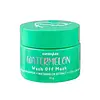What's inside
What's inside
 Key Ingredients
Key Ingredients

 Benefits
Benefits

 Concerns
Concerns

 Ingredients Side-by-side
Ingredients Side-by-side

Niacinamide
SmoothingPropylene Glycol
HumectantHydroxypropyl Methylcellulose
Emulsion StabilisingSodium PCA
HumectantCitrullus Lanatus Fruit Extract
Skin ConditioningAloe Barbadensis Leaf Extract
EmollientCollagen
MoisturisingDMDM Hydantoin
PreservativeSodium Hyaluronate
HumectantAllantoin
Skin ConditioningGellan Gum
Actinidia Chinensis Seed Extract
Skin ConditioningPhenoxyethanol
PreservativeParfum
MaskingPentylene Glycol
Skin ConditioningMethyl Diisopropyl Propionamide
MaskingCI 14720
Cosmetic ColorantCI 47005
Cosmetic ColorantNiacinamide, Propylene Glycol, Hydroxypropyl Methylcellulose, Sodium PCA, Citrullus Lanatus Fruit Extract, Aloe Barbadensis Leaf Extract, Collagen, DMDM Hydantoin, Sodium Hyaluronate, Allantoin, Gellan Gum, Actinidia Chinensis Seed Extract, Phenoxyethanol, Parfum, Pentylene Glycol, Methyl Diisopropyl Propionamide, CI 14720, CI 47005
Kaolin
AbrasiveMagnesium Aluminum Silicate
AbsorbentButylene Glycol
HumectantNiacinamide
SmoothingPolysorbate 80
EmulsifyingPolysilicone-1 Crosspolymer
Skin ConditioningCellulose
AbsorbentPhenoxyethanol
PreservativePropylene Glycol
HumectantGlycerin
HumectantCaprylic/Capric Triglyceride
MaskingCentella Asiatica Extract
CleansingHydrogenated Lecithin
EmulsifyingGelidiella Acerosa Extract
Skin ProtectingCucumis Sativus Fruit Extract
EmollientHypnea Musciformis Extract
Skin ProtectingXanthan Gum
EmulsifyingPolyacrylamide
C13-14 Isoparaffin
EmollientLaureth-7
EmulsifyingTitanium Dioxide
Cosmetic ColorantOleth-10
EmulsifyingTriethoxycaprylylsilane
Mahonia Aquifolium Root Extract
AstringentPlantago Lanceolata Leaf Extract
AntimicrobialSodium Salicylate
PreservativeCI 77007
Cosmetic ColorantCitric Acid
BufferingSodium Lactate
BufferingSodium PCA
HumectantGlycine
BufferingFructose
HumectantLactic Acid
BufferingUrea
BufferingInositol
HumectantTocopheryl Acetate
AntioxidantBee Venom
AstringentPolysorbate 60
EmulsifyingSimethicone
EmollientTetrasodium EDTA
Salicylic Acid
MaskingCI 14720
Cosmetic ColorantKaolin, Magnesium Aluminum Silicate, Butylene Glycol, Niacinamide, Polysorbate 80, Polysilicone-1 Crosspolymer, Cellulose, Phenoxyethanol, Propylene Glycol, Glycerin, Caprylic/Capric Triglyceride, Centella Asiatica Extract, Hydrogenated Lecithin, Gelidiella Acerosa Extract, Cucumis Sativus Fruit Extract, Hypnea Musciformis Extract, Xanthan Gum, Polyacrylamide, C13-14 Isoparaffin, Laureth-7, Titanium Dioxide, Oleth-10, Triethoxycaprylylsilane, Mahonia Aquifolium Root Extract, Plantago Lanceolata Leaf Extract, Sodium Salicylate, CI 77007, Citric Acid, Sodium Lactate, Sodium PCA, Glycine, Fructose, Lactic Acid, Urea, Inositol, Tocopheryl Acetate, Bee Venom, Polysorbate 60, Simethicone, Tetrasodium EDTA, Salicylic Acid, CI 14720
Ingredients Explained
These ingredients are found in both products.
Ingredients higher up in an ingredient list are typically present in a larger amount.
We don't have a description for CI 14720 yet.
Niacinamide is a multitasking form of vitamin B3 that strengthens the skin barrier, reduces pores and dark spots, regulates oil, and improves signs of aging.
And the best part? It's gentle and well-tolerated by most skin types, including sensitive and reactive skin.
You might have heard of "niacin flush", or the reddening of skin that causes itchiness. Niacinamide has not been found to cause this.
In very rare cases, some individuals may not be able to tolerate niacinamide at all or experience an allergic reaction to it.
If you are experiencing flaking, irritation, and dryness with this ingredient, be sure to double check all your products as this ingredient can be found in all categories of skincare.
When incorporating niacinamide into your routine, look out for concentration amounts. Typically, 5% niacinamide provides benefits such as fading dark spots. However, if you have sensitive skin, it is better to begin with a smaller concentration.
When you apply niacinamide to your skin, your body converts it into nicotinamide adenine dinucleotide (NAD). NAD is an essential coenzyme that is already found in your cells as "fuel" and powers countless biological processes.
In your skin, NAD helps repair cell damage, produce new healthy cells, support collagen production, strengthen the skin barrier, and fight environmental stressors (like UV and pollution).
Our natural NAD levels start to decline with age, leading to slower skin repair, visible aging, and a weaker skin barrier. By providing your skin niacinamide, you're recharging your skin's NAD levels. This leads to stronger, healthier, and younger looking skin.
Another name for vitamin B3 is nicotinamide. This vitamin is water-soluble and our bodies don't store it. We obtain Vitamin B3 from either food or skincare. Meat, fish, wheat, yeast, and leafy greens contain vitamin B3.
The type of niacinamide used in skincare is synthetically created.
Learn more about NiacinamidePhenoxyethanol is a preservative that has germicide, antimicrobial, and aromatic properties. Studies show that phenoxyethanol can prevent microbial growth. By itself, it has a scent that is similar to that of a rose.
It's often used in formulations along with Caprylyl Glycol to preserve the shelf life of products.
Propylene Glycol is an odorless, colorless liquid. As a humectant, it helps skin retain moisture. It also aids in delivering active ingredients.
Another role of this ingredient is preventing a product from melting or freezing. Propylene glycol also adds antimicrobrial properties to a product, elongating product lifespan.
This ingredient is considered an organic alcohol and commonly added into both cosmetics and foods.
Those with sensitive skin or conditions may develop a rash when using this ingredient.
Learn more about Propylene GlycolSodium PCA is the sodium salt of pyroglutamic acid. It is naturally occurring in our skin's natural moisturizing factors where it works to maintain hydration.
The PCA stands for pyrrolidone carboxylic acid, a natural amino acid derivative.
This ingredient has skin conditioning, anti-inflammatory, and humectant properties. Humectants help hydrate your skin by drawing moisture from the air. This helps keep your skin moisturized.
Learn more about Sodium PCA